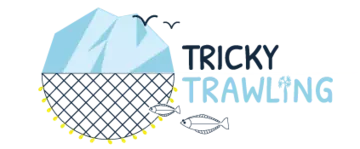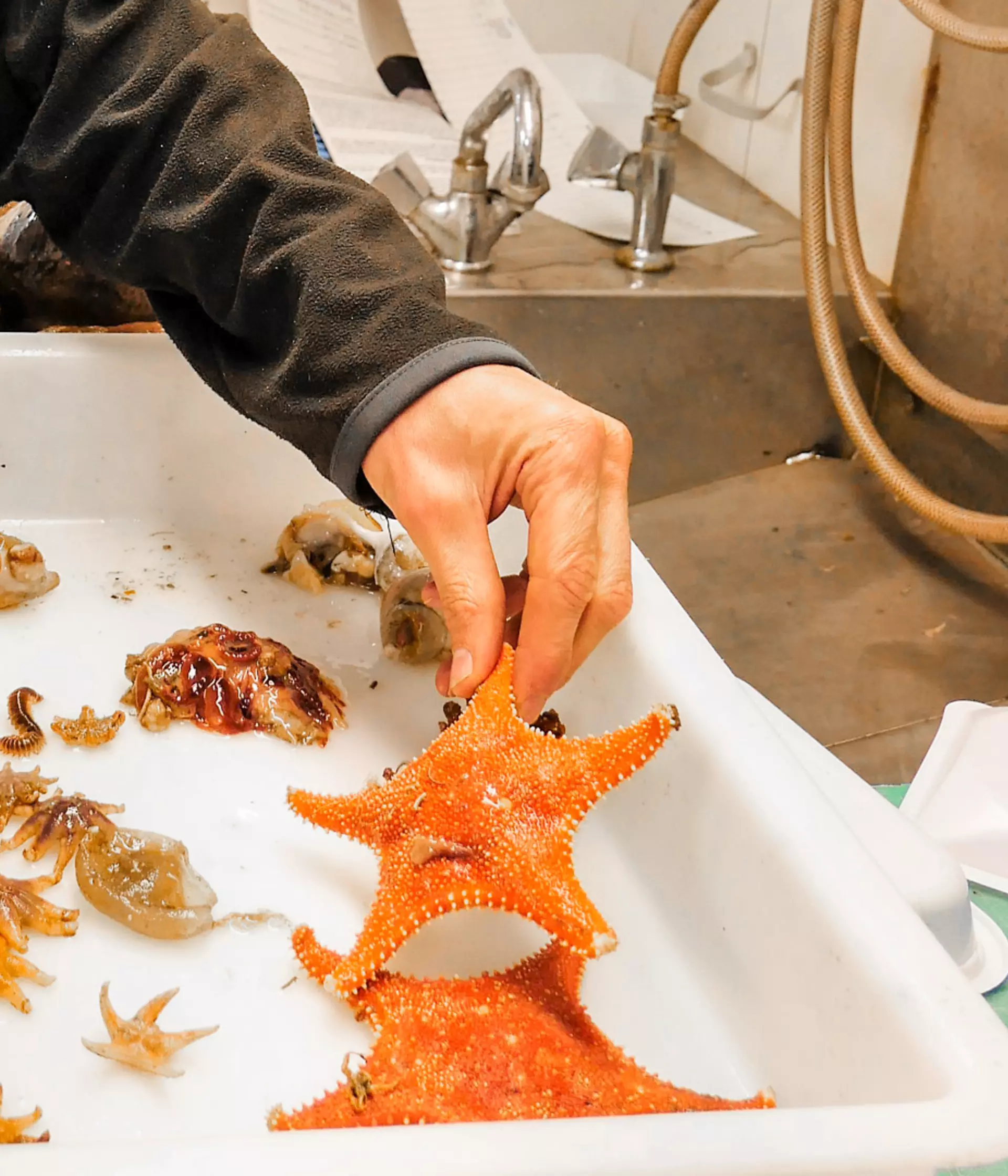Chris Yesson
Research Fellow
A project exploring the benthic habitats of the continental shelf of West Greenland to examine the impact of the shrimp trawl fishery.
Fishing is a very important industry in Greenland, so ensuring long-term sustainability is essential for both their economy and environment. The northern shrimp fishery of West Greenland is seeking certification of sustainability from the Marine Stewardship Council. As part of this process, researchers at ZSL, in partnership with the Greenland Institute of Natural Resources, are independently assessing the impact of the fishery on the seabed habitats of the area.
The seabed of West Greenland is home to many amazing organisms as well as the commercially important northern shrimp (Pandalus borealis). There are sea cumbers burrowing in the mud, starfish and brittlestars crawling on the surface, the delicate lattice frameworks of bryozoans alongside corals and sponges, to name but a few.
We are documenting and measuring the diversity to compare with fishing activity at hundreds of stations from the southern tip of Greenland, up into the Arctic circle. With this data, we will evaluate the impact of trawling on habitats in the region, and provide important evidence to assist in the conservation of these important habitats.
Image Analysis
To date, we have taken more than a thousand images of the seabed of West Greenland using a benthic camera aboard the survey vessel M/T Paamiut. You can see some images from these surveys below.
Some of these images contain hundreds of organisms (our record is more than 600 individuals in one image). To help us analyse these images we have been working with computer scientists at UCL to develop image processing software.
Habitat maps
Surveys of the seabed and time consuming and expensive. We cannot hope to examine more that a small portion of the seabed. However, we can use the limited sampling to learn about the environmental requirements of important habitat forming species. We use these data to develop habitat suitability models to predict the distribution of key species to develop more comprehensive maps of the area.
Tricky trawling game

This fun and informative game teaches about Arctic seafloor animals, the impacts of deep-sea trawling and sustainable fishery.
Can you fish without damaging the animals that live on the seafloor?
RESEARCHERS
- Kirsty Kemp (IoZ)
- Chris Yesson (IoZ)
- Stephen Long (Ioz/UCL)
Alumni
- Ed Johns (UCL)
- Mona Fuhrmann (IoZ)
Collaborators
- Greenland Institute of Natural Resources
- Sustainable Fisheries Greenland
Long S, Sparrow-Scinocca B, Blicher ME, Hammeken Arboe N, Fuhrmann M, Kemp KM, Nygaard R, Zinglersen K & Yesson C (2020) Identification of a soft coral garden candidate vulnerable marine ecosystem (VME) using video imagery, Davis Strait, west Greenland. Frontiers in Marine Science. 2020;7:460. (doi:10.3389/fmars.2020.00460)
Gougeon S, Kemp KM, Blicher ME & Yesson C (2017) Mapping and classifying the seabed of the West Greenland continental shelf. Estuarine and Coastal Shelf Science. (doi:10.1016/j.ecss.2017.01.009)
Yesson C, Fisher J, Gorham T, Turner CJ, Hammeken Arboe N, Blicher ME & Kemp KM (2016) The impact of trawling on the epibenthic megafauna of the West Greenland shelf. ICES Journal of Marine Science. (doi:10.1093/icesjms/fsw206)
Yesson C, Simon P, Chemshirova I, Gorham T, Turner CJ, Hammeken Arboe N, Blicher ME, Kemp KM (2015) Community composition of epibenthic megafauna on the West Greenland Shelf. Polar Biology.38:2085-2096. (abstract)
Student projects
Students have played an important role in our work. The following students projects have made a significant contribution to our work.
- Poppy Simon (MSc project 2013) "The effects of shrimp trawling on the macrobenthic fauna of West Greenland"
- Irina Chemshirova (Year in research 2013) "Impact of trawling on benthic marine organisms off the Greenlandic shelf, 200 to 600 meters depth"
- Irina Chemshirova (BSc project 2014) "Establishing historical baselines of benthic diversity and community composition, Western Greenland"
- Taylor Gorham (MSc project 2014) "Community composition of seabed habitats around Greenland: What is the impact of the shrimp fishery?"
- Lizzy Murphy (MSc project 2014) "Can we see the genetic fingerprint of fishing impact on the cold water corals of Western Greenland?"
- Chris Turner (MSc project 2014) "Creating a benthic habitat map for the West Greenland shelf". Read Chris' Thesis here, and see his project poster.
- Jess Fisher (Masters project 2015) "Impacts of otter trawling on macrobenthic functional diversity in western Greenland"
- Sarah Gougeon (Masters project 2015) "Mapping and classifying the seabed of West Greenland"
- Mate Vakarcs (Masters project 2015) "A temporal comparison of benthic macrofaunal communities and the impact of bottom trawling, West Greenland continental shelf"
- James Ayre (MSci project 2016) "Can we see the genetic fingerprint of fishing impact on the cold water corals of Western Greenland?"
- Jack Davies (UCL Mres 2017) “Does an alternative perspective of imaging capture additional information on benthic habitats and the impacts of otter trawling at the shrimp fishery site of West Greenland's continental shelf?”
- Amy Jenkins (York MSc 2018) “Deep Sea Lebensspuren: The influence of fishing activity on benthic infauna off the west coast of Greenland.”
- Lauren Cook (UCL MRes 2019) “Documenting cold seeps on the west coast of Greenland”
- Bridget Sparrow-Scinocca (Imperial MSc 2019) “Use of deep-sea imagery to propose a candidate vulnerable marine ecosystem (VME) in the Davis Strait, Greenland”
- Rebecca Bentley (Imperial MSc 2019) “Mitochondrial Genomes of Cauliflower Corals (Nephtheidae)”
- Eva Stewart (UCL MRes 2020) “SNPs for population genetic analysis and species delimitation of Greenland Nephtheidae corals (Octocorallia: Alcyonacea)”
- Conor Nicoll (Imperial MSc 2020) “The Hidden Habitats of Greenland: Identifying benthic community distribution within Disko Bay”
- Chris Yesson - IoZ Annual Conference, London, December 2013 (slides)
- Kirsty Kemp - ICES Symposium Effects of fishing on benthic fauna and habitats, Tromso, June 2014
- Chris Yesson - Poster presented at the Deep Sea Biology Symposium, Portugal, September 2015
- West Greenland on board Paamiut in June 2017
- Cruise report Greenland October 2017
From leading field projects on remote islands, to influencing world leader's wildlife policies, we are there wherever nature needs us.
Join us on our journey to restore the natural world.
